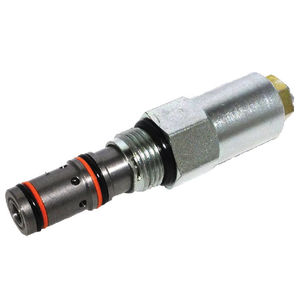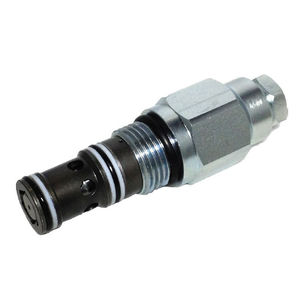
- Products
- Catalogs
- News & Trends
- Exhibitions
Bidirectional valve DCB10-MC, DCB12-MCcartridgepilotfor motors


Add to favorites
Compare this product
Characteristics
- Type
- cartridge
- Function
- pilot
- Applications
- for motors, for cylinders
- Associated function
- balancing, expansion
- Other characteristics
- bidirectional
- Pressure
210 bar, 315 bar
(3,045.8 psi, 4,568.7 psi)- Flow rate
57 l/min, 85 l/min
(15.06 us gal/min, 22.45 us gal/min)
Description
Dual counterbalance HIC, 10-size, hydraulic vent with make-up checks. This is an internally piloted, low leakage assembly. The DCB10-MC uses two CB10-HV cartridges and four CP100-3 check valves, allowing free flow from the V port to the C ports and blocks flow in the reverse direction until the relief setting is reached, or until adequate pilot pressure has been applied to the opposite V port. Connect the T port to a tank line to allow for make-up flow into the circuit.
Application
Dual counterbalance HIC’s are used for controlling loads in bidirectional motion such as wheel motor applications or for cylinders going over center. They are also suitable for use on the boom and dipper cylinder on an excavator. When make-up feature is needed, connect ‘T’ port to reservoir or charge system. This allows the load to be smoothly controlled with minimum energy loss. If load tries to run ahead of pump, pilot pressure will decrease and the relief section will throttle or close to prevent runaway. The T port is also useful in cylinder applications where directional valves (specifically proportional valves) are sensitive to flow intensification of powering the rod side. The DCB10-MC diverts flow directly to tank and bypasses the directional valve. This HIC technically replaces the 1EEC11-01.
Catalogs
No catalogs are available for this product.
See all of Comatrol‘s catalogsRelated Searches
- Valve
- Control valve
- Electrically operated valve
- Regulating valve
- Flap valve
- Non-return valve
- Directional control valve
- Normally closed solenoid valve
- 2-way solenoid valve
- Direct-operated solenoid valve
- Hydraulic directional control valve
- Fluid check valve
- Flow control valve
- 3-way valve
- Pilot-operated solenoid valve
- Spool hydraulic directional control valve
- Relief valve
- Plunger valve
- Threaded non-return valve
- High-pressure valve
*Prices are pre-tax. They exclude delivery charges and customs duties and do not include additional charges for installation or activation options. Prices are indicative only and may vary by country, with changes to the cost of raw materials and exchange rates.



